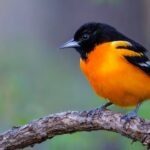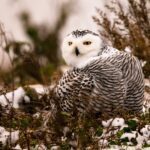Macaw Parrot Diet Habitat Facts A 99 Easy Guide
Welcome to our informative blog about the stunning and captivating Macaw Parrot! In this article, we will explore the diet, habitat, and fascinating facts about these vibrant and intelligent creatures. So, let’s dive into the world of Macaw Parrots and discover what makes them so unique and special.
Macaw parrots, with their vibrant plumage and charismatic personalities, have long captivated the hearts of bird enthusiasts around the globe. These magnificent birds, native to the rainforests of Central and South America, are known for their striking appearance and sociable nature. In this comprehensive exploration, we will delve into the intricate details of macaw parrots, focusing on their diet, habitat, and some fascinating facts that make them truly remarkable creatures.

Table of Contents
Macaw Parrot Overview
A. Classification and Species Diversity
Macaw parrots belong to the Psittacidae family, a diverse group of parrots characterized by their strong, hooked bills and zygodactyl feet. Within this family, the macaw genus (Ara) includes approximately 17 recognized species, each distinguished by its unique coloration and size.
B. Physical Characteristics
Macaws are renowned for their vibrant plumage, which spans a spectrum of colors ranging from brilliant reds and blues to radiant yellows and greens. Their large size, robust beaks, and long tails contribute to their iconic appearance. These features, combined with expressive facial feathers, make macaws easily distinguishable among other parrot species.
Macaw Parrot Diet
Macaw Parrots have a diverse and varied diet that consists of fruits, nuts, seeds, and vegetation. These colorful birds are known for their strong beaks, which they use to crack open tough nuts and seeds. Their diet also includes berries, flowers, and even insects. Macaw Parrots are quite resourceful when it comes to finding food, and they can adapt to different environments in search of sustenance.

It’s important to note that a balanced diet is crucial for the health and well-being of Macaw Parrots. Providing them with a combination of commercial pellet food, fresh fruits, vegetables, and occasional treats ensures they receive all the necessary nutrients. Consult with an avian veterinarian to determine the specific dietary needs of your Macaw Parrot.
The Macaw parrot, known for its vibrant plumage and charismatic personality, is a captivating companion that requires a carefully curated diet to thrive in captivity. Proper nutrition is crucial for the overall health, longevity, and vitality of these majestic birds. In the wild, Macaws primarily feed on a diverse array of fruits, nuts, seeds, and vegetation, and replicating this varied diet in captivity is essential for their well-being. A well-balanced Macaw parrot diet consists of a combination of commercial pellets, fresh fruits, vegetables, nuts, and occasional treats.
Commercial pellets specially formulated for large parrots, such as Macaws, serve as the foundation of their diet. These pellets are nutritionally balanced and provide essential vitamins, minerals, and amino acids necessary for the bird’s health. Pellets should make up about 60-70% of the daily diet, ensuring that the parrot receives a well-rounded nutritional profile. It’s essential to choose high-quality pellets from reputable brands, as low-quality options may lack the necessary nutrients or contain additives that could be harmful to the bird’s health.
In addition to pellets, fresh fruits and vegetables play a crucial role in a Macaw’s diet. These provide essential vitamins and antioxidants, promoting a strong immune system and vibrant plumage. Macaws enjoy a variety of fruits, including apples, oranges, bananas, berries, and mangoes. Vegetables like carrots, broccoli, kale, and bell peppers contribute to the overall nutritional balance. It’s important to offer a diverse range of fruits and vegetables to ensure the bird receives a wide spectrum of nutrients. However, caution should be exercised with fruits high in sugar, such as grapes, as excessive consumption can lead to obesity and other health issues.
Nuts are another important component of a Macaw’s diet, as they offer healthy fats and protein. Almonds, walnuts, Brazil nuts, and pistachios are among the nuts that can be offered in moderation. Nuts should be unsalted and served in their raw, natural state to avoid added preservatives or unhealthy additives. While nuts are nutrient-dense, they are also high in fat, so portion control is essential to prevent obesity. Additionally, nuts serve as a valuable source of mental stimulation for Macaws, as they enjoy cracking open the shells to access the tasty kernels inside.
Treats, though enjoyable for the parrot, should be given sparingly to avoid disrupting the nutritional balance of the overall diet. These can include small amounts of seeds, dried fruits, or bird-safe crackers. Offering treats during training sessions can be an effective way to reinforce positive behavior and strengthen the bond between the Macaw and its caregiver. However, moderation is key, as excessive treats can lead to weight gain and potential health issues.
Fresh water is a fundamental component of a Macaw’s diet and should be available at all times. Hydration is crucial for various bodily functions, including digestion and temperature regulation. Water dishes should be cleaned regularly to prevent the growth of bacteria, and the water source should be free from contaminants. Some Macaws enjoy bathing, so providing a shallow dish for them to splash around in can contribute to their overall well-being.
While providing a varied and nutritious diet is essential, it’s equally important to monitor the Macaw’s eating habits and adjust the diet accordingly. Factors such as age, activity level, and health status can influence dietary needs. Regular veterinary check-ups are crucial to assess the bird’s overall health and address any potential nutritional deficiencies or concerns. Consulting with an avian veterinarian can help create a personalized diet plan tailored to the specific needs of the individual Macaw.
Macaw Parrot Habitat
Macaw Parrots are native to the rainforests of Central and South America. These majestic birds thrive in lush, tropical environments where they can find an abundance of food and suitable nesting sites. The rainforests provide them with tall trees to perch on and ample opportunities for social interaction with other Macaw Parrots.
In captivity, Macaw Parrots require spacious cages or aviaries that mimic their natural habitat. The cage should be large enough to accommodate their size and allow for plenty of exercise. Enrichment activities, such as providing branches for climbing and toys for mental stimulation, are also essential for their well-being.

Creating an optimal habitat for Macaw parrots is crucial to their physical and mental well-being. These majestic birds, known for their vibrant plumage and sociable nature, thrive in environments that mimic their natural habitats. In the wild, Macaws inhabit dense tropical rainforests, where they can fly freely, explore diverse landscapes, and engage in social interactions with their flock. When kept in captivity, providing a spacious and enriching environment is essential to ensure the health and happiness of these intelligent and energetic birds.
One of the primary considerations when setting up a Macaw parrot habitat is the size of the enclosure. Macaws are large birds with impressive wingspans, and confining them to a small space can lead to stress, boredom, and health issues. A spacious cage or aviary that allows for ample movement, climbing, and wing-stretching is essential. The minimum recommended cage size for a single Macaw is typically at least 3 feet by 3 feet by 6 feet, but larger enclosures are highly recommended, especially for larger species like the Hyacinth Macaw. The cage should be constructed from sturdy materials, such as stainless steel, to withstand the powerful beak and talons of these birds.
In addition to the cage, Macaws benefit greatly from supervised time outside the enclosure. A secure and bird-proofed room or outdoor aviary provides an opportunity for these birds to engage in natural behaviors like flying, climbing, and exploring. Ensuring that the outdoor space is safe from predators and environmental hazards is crucial. The presence of perches, ropes, and platforms both inside and outside the cage enhances the Macaw’s environment, encouraging physical activity and preventing muscle atrophy.
Enrichment plays a pivotal role in a Macaw’s habitat, as these birds are highly intelligent and require mental stimulation to thrive. Providing a variety of toys, puzzles, and foraging activities helps prevent boredom and encourages problem-solving skills. Toys made from safe and durable materials, such as untreated wood, leather, and stainless steel, are excellent choices. Rotating toys regularly and introducing new items can keep the Macaw engaged and curious. Foraging opportunities, such as hiding treats in puzzle feeders or wrapping them in paper, not only provide mental stimulation but also encourage natural behaviors like searching for food.
Natural perches are essential for maintaining the health of a Macaw’s feet and legs. Branches of varying diameters help exercise their feet and prevent the development of pressure sores. These perches should be placed at different heights within the cage to simulate the varied heights of tree branches in the wild. Additionally, providing a cement or sand perch can help keep the bird’s nails trimmed.
Maintaining an appropriate temperature and humidity level is crucial for the well-being of Macaw parrots. These tropical birds are accustomed to warm and humid climates, so providing a consistent temperature between 70 to 80 degrees Fahrenheit is ideal. Humidity levels should be maintained around 60-70%, mimicking their natural habitat. Caregivers should be mindful of drafts and sudden temperature changes, as these can stress the birds and make them susceptible to illness.
A crucial aspect of a Macaw’s habitat is the provision of a balanced and nutritious diet. While this falls under the broader category of care rather than the physical habitat, it significantly impacts the overall well-being of the bird. A diverse and well-rounded diet, consisting of high-quality pellets, fresh fruits, vegetables, and nuts, contributes to the bird’s physical health, vibrant plumage, and overall vitality.
Social interaction is fundamental to the psychological health of Macaw parrots. In the wild, these birds form strong bonds with their flock and engage in constant communication. When kept in captivity, it’s essential to provide companionship either through the presence of other compatible birds or through regular interaction with their human caregivers. Macaws are known for their ability to mimic human speech and sounds, making them interactive and entertaining companions. However, they also require genuine social engagement and should not be left alone for extended periods.
Regular veterinary check-ups are essential to monitor the health of Macaw parrots and address any potential concerns promptly. A veterinarian with experience in avian care can provide guidance on diet, habitat setup, and general well-being. Monitoring the bird’s behavior, appetite, and droppings can offer valuable insights into its health, allowing caregivers to address any issues promptly.
Macaw Parrot Facts
These large, intelligent birds belong to the family Psittacidae and are native to the rainforests of Central and South America. Renowned for their striking colors, Macaws come in a variety of species, each with its unique characteristics. One of the most impressive members of this family is the Hyacinth Macaw (Anodorhynchus hyacinthinus), recognized for its vibrant cobalt-blue feathers and massive size, making it the largest of all parrots. Alongside the Hyacinth, other well-known Macaw species include the Scarlet Macaw, Blue and Gold Macaw, Green-winged Macaw, and Military Macaw, each displaying a kaleidoscope of colors that range from vivid reds and blues to vibrant greens and yellows.
One of the distinctive features of Macaw parrots is their exceptional intelligence. These birds are known for their ability to learn and mimic human speech, sounds, and even complex tasks. In the wild, Macaws use vocalizations to communicate within their flock, establishing strong social bonds. In captivity, they can develop an extensive vocabulary and often display a remarkable talent for imitation. The Green-winged Macaw, for example, is particularly renowned for its talkative nature, with the ability to mimic a wide range of sounds, including doorbells and telephone rings.
Macaws are highly social creatures, forming close-knit family groups in their natural habitat. They thrive on interaction and companionship, whether it be with fellow Macaws or their human caregivers. In the wild, these birds engage in playful activities, mutual grooming, and communal roosting. In captivity, providing ample social stimulation is crucial for their mental well-being. Macaws may form strong bonds with their owners and can experience stress or loneliness if left alone for extended periods. Regular interaction, playtime, and the opportunity to engage in natural behaviors contribute to a healthy and happy Macaw.
Another fascinating aspect of Macaw parrots is their impressive lifespan. In the wild, these birds can live up to 60 years or more, depending on the species and environmental factors. In captivity, with proper care and nutrition, Macaws often outlive many other pet birds. The commitment to caring for a Macaw is substantial, as their long lifespan requires a lifelong dedication from their caregivers. The bond formed with a Macaw can be deeply rewarding, but potential owners must be prepared for the responsibilities associated with the bird’s extended lifespan.
The Macaw’s diet is a crucial factor in its overall health and vitality. In the wild, Macaws are omnivores, feeding on a diverse array of fruits, nuts, seeds, and vegetation. Captive Macaws should be provided with a well-balanced diet that includes high-quality commercial pellets as the foundation. Fresh fruits and vegetables contribute essential vitamins and minerals, while nuts offer healthy fats and protein. It’s important to avoid feeding Macaws foods high in sugar, salt, or additives, as these can lead to health issues. Regular access to clean, fresh water is fundamental, as dehydration can pose significant risks to their health.
Macaw parrots are renowned for their strong beaks, which they use not only for cracking open nuts but also for climbing, manipulating objects, and exploring their surroundings. The beak, made of keratin, grows continuously throughout their lives, and providing a variety of toys, branches, and safe items to chew on helps keep their beak healthy and prevents overgrowth. Macaws enjoy shredding and chewing on items, and caregivers should provide safe, bird-friendly materials to satisfy this natural behavior.
The impressive and vibrant plumage of Macaw parrots serves several purposes beyond their aesthetic appeal. The colors play a role in communication, with the birds using their striking feathers to attract mates and establish dominance within the flock. Additionally, the bright colors act as a form of camouflage in their natural habitat, helping them blend into the lush, colorful surroundings of the rainforest. The feathers also play a role in thermoregulation, allowing the Macaws to control their body temperature by adjusting the positioning of their feathers.
Conservation efforts are crucial to the survival of many Macaw species, as habitat loss, illegal pet trade, and environmental changes pose significant threats. Several Macaw species are listed as endangered or vulnerable, emphasizing the need for proactive measures to protect their natural habitats and combat illegal wildlife trade. Conservation organizations work tirelessly to raise awareness, conduct research, and implement programs to safeguard the future of these remarkable birds.
- Macaw Parrots are famous for their vibrant plumage, which comes in a wide range of colors, including blue, red, yellow, and green. Each individual Macaw Parrot has a unique combination of colors, making them truly one-of-a-kind.
- These parrots are highly intelligent and can mimic human speech with proper training and socialization. They have an impressive ability to imitate sounds and voices, which adds to their charm and appeal.
- Macaw Parrots are social creatures and form strong bonds with their human caregivers. They thrive on interaction and require plenty of mental stimulation to prevent boredom.
- With a lifespan of up to 60 years or more, Macaw Parrots make lifelong companions and can be a significant commitment for potential owners. It’s essential to consider their long lifespan and the responsibility that comes with caring for them.
- Unfortunately, many Macaw Parrot species are endangered due to habitat loss and illegal capture for the pet trade. Conservation efforts are critical to protect these magnificent birds and ensure their survival in the wild.
Important To Know,
Macaw Parrots are truly captivating creatures with their stunning colors, intelligence, and sociable nature. Understanding their diet, habitat, and unique characteristics is fundamental to providing them with the care they need and deserve. By respecting and protecting these incredible birds, we can contribute to their conservation and help maintain their presence in our world.
We hope you enjoyed this in-depth look into the world of Macaw Parrots. If you have any further questions or would like to share your own experiences with these magnificent birds, please feel free to leave a comment below. Happy bird watching!
African Gray Parrot A 99 Comprehensive Easy Guide
Snowy Owl Arctic Majesty Diet-Habitat-Facts
Baltimore Oriole The Symbol of Beauty and Song
For More Posts Click Here










